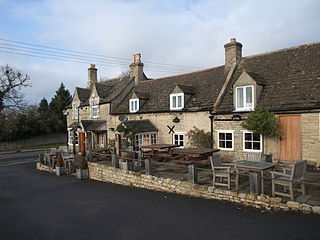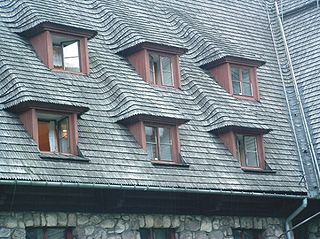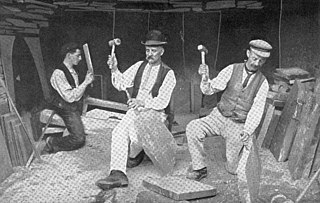 W
WRoof tiles are designed mainly to keep out rain, and are traditionally made from locally available materials such as terracotta or slate. Modern materials such as concrete, metal and plastic are also used and some clay tiles have a waterproof glaze.
 W
WTiles are thin objects, usually square or rectangular in shape. A tile is a manufactured piece of hard-wearing material such as ceramic, stone, metal, baked clay, or even glass, generally used for covering roofs, floors, walls, or other objects such as tabletops. Alternatively, tile can sometimes refer to similar units made from lightweight materials such as perlite, wood, and mineral wool, typically used for wall and ceiling applications. In another sense, a tile is a construction tile or similar object, such as rectangular counters used in playing games. The word is derived from the French word tuile, which is, in turn, from the Latin word tegula, meaning a roof tile composed of fired clay.
 W
WGlazed tiles have been used in China since the Zhou Dynasty as a material for roofs. During the Song Dynasty, the manufacture of glazed tiles was standardized in Li Jie's Architecture Standard. In the Ming Dynasty and Qing Dynasty, glazed tiles became ever more popular for top-tier buildings, including palace halls in the Forbidden City, and ceremonial temples.
 W
WCollyweston stone slate is a traditional roofing material found in central England.
 W
WA grouted roof is a form of slate roof. It has developed as a form of vernacular architecture associated with the West coast of the British Isles.
 W
WThe House of the Tiles is a monumental Early Bronze Age building located at the archaeological site of Lerna in southern Greece. It is notable for several architectural features that were advanced for its time, notably its roof covered by baked tiles, which gave the building its name. The building belongs to the "corridor house" type.
 W
WThe imbrex and tegula were overlapping roof tiles used in ancient Greek and Roman architecture as a waterproof and durable roof covering. They were made predominantly of fired clay, but also sometimes of marble, bronze or gilt. In Rome, they replaced wooden shingles, and were used on almost every type of structure, from humble outbuildings to grand temples and public facilities.
 W
WChinese imperial roof decorations or roof charms or roof-figures or "walking beasts" or "crouching beasts" were statuettes placed along the ridge line of official buildings of the Chinese empire. Only official buildings were permitted to use such roof decorations.
 W
WMonk and Nun is a style of roof similar to imbrex and tegula, but instead of using a flat tile (tegula) and an arched tile (imbrex), two arched imbrex tiles are used.
 W
WOnigawara are a type of roof ornamentation found in Japanese architecture. They are generally roof tiles or statues depicting a Japanese ogre (oni) or a fearsome beast. Prior to the Heian period, similar ornaments with floral and plant designs (hanagawara) preceded the onigawara. The present design is thought to have come from a previous architectural element, the oni-ita, which is a board painted with the face of an oni and was meant to stop roof leaks. During the Nara period the tile was decorated with other motifs, but later it acquired distinct ogre-like features and became strongly tridimensional. Onigawara are most often found on Buddhist temples. The tile's name notwithstanding, the ogre's face may be missing.
 W
WA pantile is a type of fired roof tile, normally made from clay. It is S-shaped in profile and is single lap, meaning that the end of the tile laps only the course immediately below. Flat tiles normally lap two courses.
 W
WRoof shingles are a roof covering consisting of individual overlapping elements. These elements are typically flat, rectangular shapes laid in courses from the bottom edge of the roof up, with each successive course overlapping the joints below. Shingles are held by the roof rafters and are made of various materials such as wood, slate, flagstone, metal, plastic, and composite materials such as fibre cement and asphalt shingles. Ceramic roof tiles, which still dominate in Europe and some parts of Asia, are still usually called tiles. Roof shingles may deteriorate faster and need to repel more water than wall shingles. They are a very common roofing material in the United States.
 W
WShibi is a Japanese ornamental tile set on both ends of the ridgepole that tops a shingled roof. The kanji for the word mean "kite" and "tail" respectively. Because it resembles a shoe, it is sometimes also called a kutsugata (沓形), meaning "shoe shape".
 W
WThe existence of a slate industry in Wales is attested since the Roman period, when slate was used to roof the fort at Segontium, now Caernarfon. The slate industry grew slowly until the early 18th century, then expanded rapidly until the late 19th century, at which time the most important slate producing areas were in northwest Wales, including the Penrhyn Quarry near Bethesda, the Dinorwic Quarry near Llanberis, the Nantlle Valley quarries, and Blaenau Ffestiniog, where the slate was mined rather than quarried. Penrhyn and Dinorwig were the two largest slate quarries in the world, and the Oakeley mine at Blaenau Ffestiniog was the largest slate mine in the world. Slate is mainly used for roofing, but is also produced as thicker slab for a variety of uses including flooring, worktops and headstones.
 W
WTraditional Korean roof construction has traditionally used many kinds of natural materials. They are made of neowa (shingle), giwa (tiles), byeotjib, stone giwa (tiles), eoksae (eulalia) and goolpy